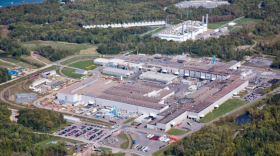New York's energy consumers will foot the bill for the decision by the Public Service Commission (PSC) to save the state's nuclear power plants, which is part of a clean energy initiative. But the commission said the increase in energy rates to subsidize the plants will actually save the state and consumers a lot of money in the long-run.
PSC Chair AudreyZibelman said supporting nuclear power plants, many of which are on the brink of closure because of competition from cheap natural and oil, will help New York reduce its carbon dioxide emissions and thus energy costs.
"Clean energy itself ends up being the cheapest resource and so we’re doing everything we can to promote really a system that moves toward a diverse network that is at least 50 percent renewably based, but at the same time we're doing it to reduce carbon," Zibelman said.
Fewer carbon emissions means a reduction in health consequences from those toxins too, which is referred to as the social cost of carbon. The PSC said that the initial $965 million subsidy from 2017 to 2019 will help the state realize $5 billion in supply cost savings and property tax benefits. They estimate the average homeowner will see only about a $1-2 monthly surcharge for the program during those initial years of the program.
There's also a benefit to having more producers bidding in the energy market, says Assemblyman Will Barclay (R-Pulaski).
"There is going to be a cost to it, but I actually believe it's going to end up saving us money because at some point - if we don’t do this we will be over reliant on natural gas or some other type of energy and those prices fluctuate and when those prices go up, we will be be paying the price for that if we didn't keep diversity in our fuel source," Barclay said.
The PSC won't estimate the ultimate price tag for the subsidy program, which ends in 2029, because it will be assessed every two years and revised to reflect the changing cost of energy prices. Tim Judson with the Nuclear Resource and Information Center, who criticizes the plan, believes it could run $7.6 billion or more. He said that while that may only mean a couple extra dollars for the average person, it will make a huge dent in the budget for larger consumers.
"That's going to place a lot of strain on local governments for their budgets," Judson said. "It's going to place a big strain on a lot of our local businesses especially manufacturers and hospitals. That could lead to local property tax increases, it could lead to business closures. I mean this decision the PSC has made will is going to cause pain throughout the state in order to avoid some short term pain for the communities that host nuclear power plants."
Judson and environmentalists say the cost of keeping these aging nuclear plants online for another 12 years could be incalculable should one of them malfunction.
The nuclear subsidies are part of New York's Reforming Our Energy Vision, which aims to reduce carbon emissions, which nuclear plants do not emit, and double the state's pool of renewable energy resources.








